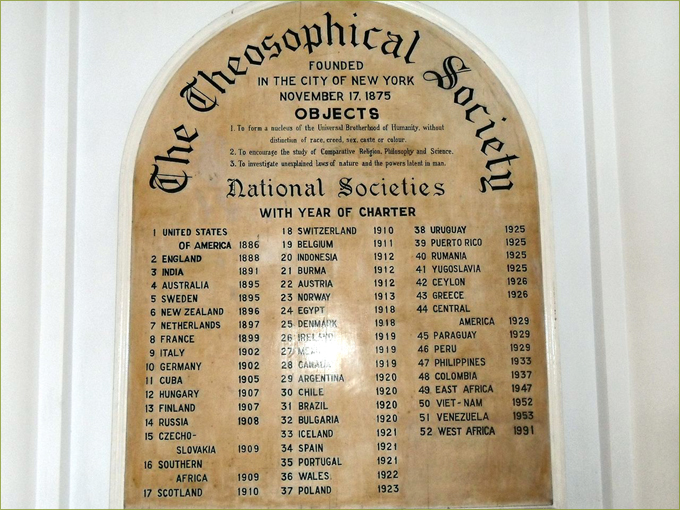

Theosophical Society Arrives in the Boundary
BY: BG EDITOR

Commemorative plaque of Theosophical Society, Adyar, India
Feb 01, 2020 — GREENWOOD, BC (BG)
Aside from debates over liberal vs. conservative politics, or the sometimes heated exchanges about Socialism, it seems the residents of early Greenwood did not have many opportunities to hear about other schools of philosophy. But on one occasion, in the spring of 1897, Greenwood gave audience to a proponent of the Theosophical Society. His influence would remain in the Boundary, in the form of a society branch in Grand Forks. A report on his opening lecture is found in a March 1897 issue of the Boundary Creek Times:[1]
AN INTERESTING LECTURE
"An extremely interesting lecture on "Theosophy" was given in the schoolhouse on Monday evening by Mr. B. A. Welbon. The room was well filled and the lecturer's remarks received, as they deserved, a close attention.
Mr. Welbon began by reading an extract from a Hindoo devotional work, as he explained was customary at theosophical gatherings. He then went on to state what theosophy was. Theosophy, he said, was not a sectional religion. Theosophy embraced all true religions, true sciences, true philosophies, and contained in one system all systems of thought. It was known as the ancient wisdom religion, the word, theosophy, being derived from the Greek theos, god, and sophia, wisdom.
Confucius, the first known teacher, Buddha, Zoroaster, Jesus, Plato, Theocritus, taught theosophy, and in more modern times Jacob Boehm, Swedenburg and many others. A theosophical society' was founded in New York [in] the year 1875 by Madame Blavatski, having three objects:
(1) The formation of a nucleus of the universal brotherhood of man;
(2) the study of ancient and modern science, religion and philosophy; and
(3) investigation into the hidden forces of nature and latent psychical powers of man.
Theosophy does not try to break down existing thought, but recognizes truth in all religions. The fundamental, principles, however, underlying the doctrine are based on reincarnation, and the ethical relationship on all planes of being resulting from "Carma," a Sanskrit word corresponding to the English "cause and effect." Cause can never be divorced from its effect. Every act in life must produce some result. This was the universal law of nature.
The law of re-incarnation is the means whereby cause and effect can manifest itself. If this is not so, we must admit that the Almighty is not just, otherwise would he create one soul to inhabit a body of a child born in the gutter and another born in the palace? This that re-incarnates is the re-incarnated ego. The real WE is not what is seen, that is continually changing. If this is true we must have lived before.
Darwin taught the evolution of man from the lower species; theosophists, on the contrary, believe that it was the involution into matter caused the evolution out of matter. They divide man into seven parts, the astral body, source of strength; the body of desires, source of all evil passions; the life principle, compelling involuntary movements. These do not endure, but the real man, the mind, soul and spirit is immortal. The spirit was the ray from the Supreme, and the soul is the vehicle for carrying that ray to the mind.
Perfectness must be attained here on earth, and here was the soul's hell. When the many times re-incarnated soul had reached that stage when cause and effect were equally balanced, it could pass to Nirvana or Heaven. Heaven to theosophists was a place where all the noble strivings of life could be accomplished. A place of action. A soul could return if it wished to earth from Nirvana and become a great teacher of truth; of such were Confucius, Buddha, Jesus.
At the close of his lecture Mr. Welbon was tendered a hearty vote of thanks."
"An extremely interesting lecture on "Theosophy" was given in the schoolhouse on Monday evening by Mr. B. A. Welbon. The room was well filled and the lecturer's remarks received, as they deserved, a close attention.
Mr. Welbon began by reading an extract from a Hindoo devotional work, as he explained was customary at theosophical gatherings. He then went on to state what theosophy was. Theosophy, he said, was not a sectional religion. Theosophy embraced all true religions, true sciences, true philosophies, and contained in one system all systems of thought. It was known as the ancient wisdom religion, the word, theosophy, being derived from the Greek theos, god, and sophia, wisdom.
Confucius, the first known teacher, Buddha, Zoroaster, Jesus, Plato, Theocritus, taught theosophy, and in more modern times Jacob Boehm, Swedenburg and many others. A theosophical society' was founded in New York [in] the year 1875 by Madame Blavatski, having three objects:
(1) The formation of a nucleus of the universal brotherhood of man;
(2) the study of ancient and modern science, religion and philosophy; and
(3) investigation into the hidden forces of nature and latent psychical powers of man.
(2) the study of ancient and modern science, religion and philosophy; and
(3) investigation into the hidden forces of nature and latent psychical powers of man.
Theosophy does not try to break down existing thought, but recognizes truth in all religions. The fundamental, principles, however, underlying the doctrine are based on reincarnation, and the ethical relationship on all planes of being resulting from "Carma," a Sanskrit word corresponding to the English "cause and effect." Cause can never be divorced from its effect. Every act in life must produce some result. This was the universal law of nature.
The law of re-incarnation is the means whereby cause and effect can manifest itself. If this is not so, we must admit that the Almighty is not just, otherwise would he create one soul to inhabit a body of a child born in the gutter and another born in the palace? This that re-incarnates is the re-incarnated ego. The real WE is not what is seen, that is continually changing. If this is true we must have lived before.
Darwin taught the evolution of man from the lower species; theosophists, on the contrary, believe that it was the involution into matter caused the evolution out of matter. They divide man into seven parts, the astral body, source of strength; the body of desires, source of all evil passions; the life principle, compelling involuntary movements. These do not endure, but the real man, the mind, soul and spirit is immortal. The spirit was the ray from the Supreme, and the soul is the vehicle for carrying that ray to the mind.
Perfectness must be attained here on earth, and here was the soul's hell. When the many times re-incarnated soul had reached that stage when cause and effect were equally balanced, it could pass to Nirvana or Heaven. Heaven to theosophists was a place where all the noble strivings of life could be accomplished. A place of action. A soul could return if it wished to earth from Nirvana and become a great teacher of truth; of such were Confucius, Buddha, Jesus.
At the close of his lecture Mr. Welbon was tendered a hearty vote of thanks."
Given that we find no report of a similar lecture being held in Grand Forks, it seems likely that a number of Grand Forks residents attended the Greenwood lecture, as evidenced by this item in the Grand Forks Miner a few months later:[2]
A BRANCH ORGANIZED IN THIS CITY STUDY THEOSOPHY
"A Theosophical society has been organized in this city and bids fair to become a strong branch. It starts out with seven charter members, and a number have expressed their intention of joining who did not attend the first meeting.
The charter members are G. B. Stocking, president; Mrs. N. Larsen, vice-president; Mrs H. A. Sheads, secretary; Mrs. McFarland, treasurer; Dr. G. W. Hepworth, Frank Reynolds and Neils Larson.
The society has been named the Welbon Branch Theosophical society of Grand Forks, in honor of B. A. Welbon, of Seattle, the organizer. Meetings will be held every Sunday evening at the residence of N. Larson, corner of Third and Spokane avenue."
The charter members are G. B. Stocking, president; Mrs. N. Larsen, vice-president; Mrs H. A. Sheads, secretary; Mrs. McFarland, treasurer; Dr. G. W. Hepworth, Frank Reynolds and Neils Larson.
The society has been named the Welbon Branch Theosophical society of Grand Forks, in honor of B. A. Welbon, of Seattle, the organizer. Meetings will be held every Sunday evening at the residence of N. Larson, corner of Third and Spokane avenue."
Throughout the summer of 1897 the Theosophical Society continued to run ads in the Grand Forks Miner, inviting participants to their meetings. Meanwhile, B. A. Welbon, who resided in Ballard, a suburb of Seattle, lectured at the Seattle branch of the society he had founded and continued to travel and lecture in Vancouver and elsewhere in the region.[3]

Helena Blavatsky
[ Image: Mauricio Planel, Mundo Estranho ]
The Boundary Creek Times report on B. A. Welbon's lecture in Greenwood notes that he opened his comments by reading from a Hindu devotional work. This was most likely the Bhagavad-gita, a treatise found in the epic Mahabharata, and one of the Upanishads. The Upanishads form the basis for the six great schools of Indian philosophy. Bhagavad-gita was frequently quoted by the early Theosophists.
The founder of the Theosophical Society, Madam Blavatsky had travelled to India, where she was introduced to the Vedas, including Bhagavad-gita. These transcendental teachings had an enormous influence on her, and she endeavoured to encapsulate her learning and experience, bringing it back to the west in the form of her own lectures and writings for the English-speaking public. Unfortunately, much of the true Vedic philosophy was lost in translation, i.e., her summaries were not true to the original ancient Vedas.
In addition to speculatively misinterpreting the Vedas, Blavatsky erred in attempting to make Vedic philosophy palatable to the western mind. Consequently, the teachings of her Theosophical Society were, and remain to this day, a watered down and simply incorrect version of the Truth embodied in the Vedas. Over the years this has given rise to many other unbonafide schools of philosophy and so-called spiritual practice.
FOOTNOTES:
[1] Boundary Creek Times — Mar 13, 1897, p. 5
https://open.library.ubc.ca/collections/bcnewspapers/xboundarycr/items/1.0170455
[2] The Grand Forks Miner — June 12, 1897, p. 1
https://tinyurl.com/t6dbapg
[3] The Theosophical Forum — Volume 2, p. 123
https://tinyurl.com/umlju2z


